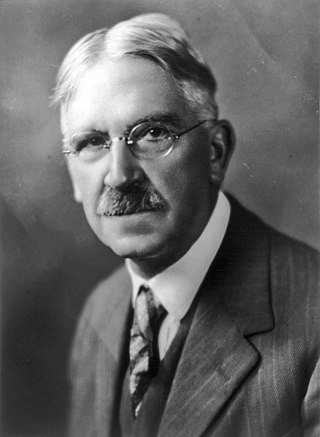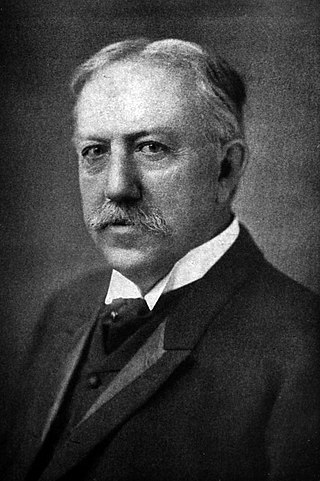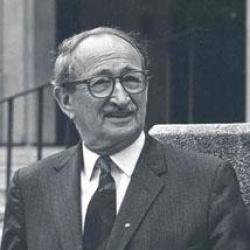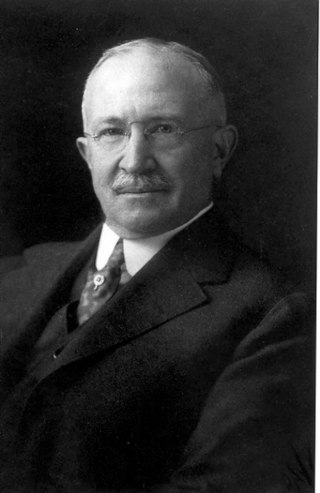
John Dewey was an American philosopher, psychologist, and educational reformer. He was one of the most prominent American scholars in the first half of the twentieth century.

Andrew Dickson White was an American historian and educator who cofounded Cornell University and served as its first president for nearly two decades. He was known for expanding the scope of college curricula. A politician, he had served as state senator in New York. He was later appointed as an American diplomat to Germany and Russia, among other responsibilities.

Joseph Glanvill was an English writer, philosopher, and clergyman. Not himself a scientist, he has been called "the most skillful apologist of the virtuosi", or in other words the leading propagandist for the approach of the English natural philosophers of the later 17th century. In 1661 he predicted "To converse at the distance of the Indes by means of sympathetic conveyances may be as natural to future times as to us is a literary correspondence."

John Fiske was an American philosopher and historian. He was heavily influenced by Herbert Spencer and applied Spencer's concepts of evolution to his own writings on linguistics, philosophy, religion, and history.

David Starr Jordan was the founding president of Stanford University, serving from 1891 to 1913. He was an ichthyologist during his research career. Prior to serving as president of Stanford University, he had served as president of Indiana University from 1884 to 1891.

John William Draper was an English-born American scientist, philosopher, physician, chemist, historian and photographer. He is credited with producing the first clear photograph of a female face (1839–40) and the first detailed photograph of the moon in 1840. He was also the first president of the American Chemical Society (1876–77) and a founder of the New York University School of Medicine.

Sidney Hook was an American philosopher of pragmatism known for his contributions to the philosophy of history, the philosophy of education, political theory, and ethics. After embracing communism in his youth, Hook was later known for his criticisms of totalitarianism, both fascism and Marxism–Leninism. A social democrat, Hook sometimes cooperated with conservatives, particularly in opposing Marxism–Leninism. After World War II, he argued that members of such groups as the Communist Party USA and Leninists like democratic centralists could ethically be barred from holding the offices of public trust because they called for the violent overthrow of democratic governments.

The Bertrand Russell Case, known officially as Kay v. Board of Higher Education, was a case concerning the appointment of Bertrand Russell as Professor of Philosophy of the College of the City of New York, as well as a collection of articles on the aforementioned case, edited by John Dewey and Horace M. Kallen.

Edward Alsworth Ross was a progressive American sociologist, eugenicist, economist, and major figure of early criminology.
The conflict thesis is a historiographical approach in the history of science that originated in the 19th century with John William Draper and Andrew Dickson White. It maintains that there is an intrinsic intellectual conflict between religion and science, and that it inevitably leads to hostility. The consensus among historians of science is that the thesis has long been discredited, which explains the rejection of the thesis by contemporary scholars. Into the 21st century, historians of science widely accept a complexity thesis.

George Lincoln Burr was a US historian, diplomat, author, and educator, best known as a Professor of History and Librarian at Cornell University, and as the closest collaborator of Andrew Dickson White, the first President of Cornell.

The Hedgehog, the Fox, and the Magister's Pox (2003) is Stephen Jay Gould's posthumous volume exploring the historically complex relationship between the sciences and the humanities in a scholarly discourse.
Le Roy Edwin Froom was a Seventh-day Adventist minister and historian whose writings and interpretations are a cause of much debate in the Adventist Church. He also was a central figure in the meetings with evangelicals that led to the producing of the theological book, Questions on Doctrine which easily qualifies as the most divisive book in Seventh-day Adventist history.

Charles Henry Gilbert was a pioneer ichthyologist and fishery biologist of particular significance to natural history of the western United States. He collected and studied fishes from Central America north to Alaska and described many new species. Later he became an expert on Pacific salmon and was a noted conservationist of the Pacific Northwest. He is considered by many as the intellectual founder of American fisheries biology. He was one of the 22 "pioneer professors" of Stanford University.

The myth of the flat Earth, or the flat-Earth error, is a modern historical misconception that European scholars and educated people during the Middle Ages believed the Earth to be flat.

Robert Richardson Sears was an American psychologist who specialized in child psychology and the psychology of personality. He was the head of the psychology department at Stanford and later dean of the School of Humanities and Sciences there, continued the long-term I.Q. studies of Lewis Madison Terman at Stanford, and authored many pivotal papers and books on various aspects of psychology.

American philosophy is the activity, corpus, and tradition of philosophers affiliated with the United States. The Internet Encyclopedia of Philosophy notes that while it lacks a "core of defining features, American Philosophy can nevertheless be seen as both reflecting and shaping collective American identity over the history of the nation". The philosophy of the Founding Fathers of the United States is largely seen as an extension of the European Enlightenment. A small number of philosophies are known as American in origin, namely pragmatism and transcendentalism, with their most prominent proponents being the philosophers William James and Ralph Waldo Emerson respectively.
Scudder Klyce was an American philosopher, scientist and naval officer. He is known for his work, Universe, which attempted to accumulate the knowledge of mankind into a single book to collect and deliver a solution for all the problems of humanity.

A History of the Warfare of Science with Theology in Christendom was published in two volumes by Andrew Dickson White, a founder of Cornell University, in 1896. In the introduction White states the original goal of his 1874 lecture on The Battlefields of Science and elaborated in a book The Warfare of Science the same year:
In all modern history, interference with science in the supposed interest of religion, no matter how conscientious such interference may have been, has resulted in the direst evils both to religion and to science, and invariably; and, on the other hand, all untrammelled scientific investigation, no matter how dangerous to religion some of its stages may have seemed for the time to be, has invariably resulted in the highest good both of religion and of science.